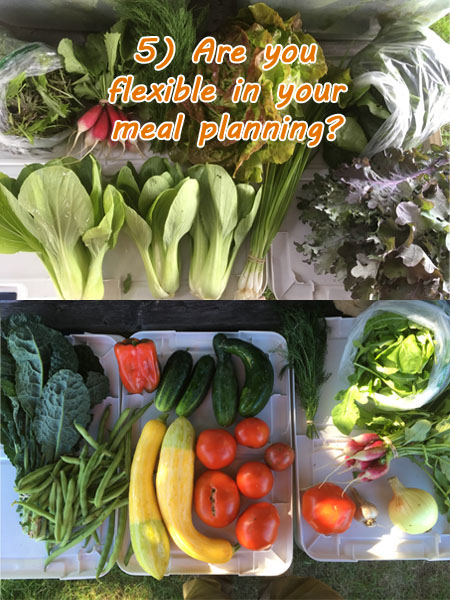Is the CSA right for you?
(It isn’t for everyone.)
You’ve heard of CSA’s for years. Maybe you’ve even been apart of one at another farm.
You’re curious about it because you want to support local farms, but you’re not sure if the CSA is how to do it.
This article will give you the clarity you’ve been looking for.
We are a CSA farm. It’s what we do. It works for us, and it may work for you too.
The truth is that the CSA is not a good fit for everyone and that’s perfectly okay.
Over the last six years, we’ve learned a lot about our customers who thrive in the CSA and return year after year, while others discover that they prefer another way of supporting local farmers.
Here are 7 questions that you should ask yourself while you’re considering joining our CSA.
When we asked last year's members to define the CSA in a nutshell, we were shocked to see how similar everyone answers were.
"Good local food that helps to support a local farm." Gina-North Berwick
"A great way to get fresh local veggies and support a local farmer." Anna-Newfields
"The best way to get fresh vegetables and support a local farm." Jonny-Epping
It's not a coincidence. That strong sense of support is inherent in the CSA model.
No other way of eating involves committing months in advance to one local farm to provide the vegetables you'll eat through the growing season.
It's a commitment that involves a bit of risk. Extreme conditions such as droughts, floods, hail, pests and diseases always have potential to cut harvests short without a refund.
CSA members understand that risk but choose to have the farmers' back, no matter what.
They value directly supporting their farmer as much as they value getting the full financial value of their share.
And it goes both ways. Once you join the CSA, we work to cultivate a relationship with you too.
Beyond our commitment to providing you with the highest quality vegetables, we offer events on the farm, informative newsletters, a private Facebook group and more to help you succeed at getting the most from your CSA experience.
This should be an easy one.
Some CSA members are great cooks. Some aren't.
What they all share is that they value using real, fresh ingredients and recognize the HUGE difference they make in any meal.
I love hearing from members that their kids won't eat tomatoes or carrots or specific other vegetables that didn't come from their CSA share.
For them, it’s not decision based in economics, ecology, sociology or politics.
It’s simply based on taste.
There is a palatable difference with these fresh vegetables and that's part of what you're paying for.
Members who find their weekly pickup time/location to be convenient are usually the most likely to satisfied with their CSA experience.
Convenience matters.
We have pickups in five different neighborhoods to reach people where they are.
Hopefully one of those times/locations fits into your schedule rather easily.
The reality is that the pickup windows are limited to the times stated on the farm website.
I often give the example of a concert. You bought the ticket, but if you show up three hours (or two days) later you shouldn't expect to see a show.
While alternate pickup options can sometimes be accommodated, they often don't work out.
If the pickup location and time are a good fit for you, the rest is a breeze.
Easy parking.
No crowds.
No rush to be first before the good stuff is sold out.
Conveniences that farmers' markets don't offer.
Take a quick scan of all the different veggies we're aiming to harvest this year.
Most of them are likely to be familiar.
There's probably a few that pop out as things you aren’t comfortable with and wouldn't normally buy for yourself like fennel or rutabaga.
Diversity is important in our garden.
For CSA members, those few foreign items aren't greeted with fear but as an inspiration for creativity in their cooking and eating.
"Bok Choy. I had never had it before and it turned out to be one of my favorites. Sauteed with some butter, salt and pepper, yum." Chrissy - Stratham
And remember, you're not on your own here.
Our weekly newsletters include recipes and techniques that target those less familiar and less popular veggies.
Also the private CSA Facebook group give you access to dozens of other members working with the same items.
We’ve been doing this for years.
We know which vegetables are the most popular and which ones are the outliers, so we plan our garden and compose our weekly shares with that in mind.
In our CSA, we pack the shares so you don’t get to choose which items you want each week.
And you often don't know exactly which delicious veggies are in your share each week until you pick it up.
Our weekly newsletter does include a sneak peak at what's likely to be harvested the following week, but it's not always accurate.
That’s the nature of working with nature.
Our happiest CSA members welcome these weekly surprises.
They appreciate not having to make choices between what to take and what to leave behind.
They find inspiration in the ingredients they receive.
Others find it stressful because it’s too hard to plan a menu around.
Are you able to give up some control of your menu and accept the uncertainty that nature offers?
If you've never been in a CSA before, it'll probably take some time to get used to the structure.
You’ll be inviting these tasty ingredients into your home each week, not just for special occasions or because you happen to make it to market that morning.
You don’t make a grocery trip whenever you see you’re refrigerator is empty.
You restock because it’s Tuesday (or Thursday).
After talking with many members after their first year, they usually talk about their difficulties getting through the entire share each week, especially in the first half of the season.
This is a fundamental and long-term change to how you eat.
You'll have to keep an open mind during this new adventure and go easy on yourself if you end up wasting some food in the beginning.
It gets easier week to week and month to month.
Understand that your choice to source your food and eat this way will require some new skills that take some time and effort to get comfortable with.
We'll teach you along the way, and if you're committed to learning, you can totally do it!
So do you have the resolve to work at eating the CSA way?
You may be tempted to look at the cost of joining the CSA and compare that to grocery store prices.
I'll confirm your suspicion. Our vegetables costs more.
I can go into the many reasons why, but the truth is that most experienced CSA members find that to be a false comparison.
It's not to say that price isn't important (of course it is), but it's at least equally important to consider the added values of the CSA:
Higher quality of produce grown without pesticides, herbicides or fungicides.
Freshness of being grown locally
Inclusion in a community of like-minded members
Supplementary recipes, tips and techniques created just for you
Access to the farmer who grows for you
Connection to a piece of farmland you can visit and the support to help you succeed in eating this way
Just to name a few.
CSA members appreciate these added values, and are willing to pay for them.
I sincerely believe that the CSA is a deal of a lifetime.
But if you think a carrot is just a carrot and should cost the same as all other carrots, you're probably not ready for the CSA experience just yet.
That's it. Did you pass?
The CSA has the ability to change the way you eat forever!
But remember, it is just one of several ways to support local farmers.
And just because it's the only way to get veggies from this farm, you shouldn't feel bad if it doesn't fit your style.









